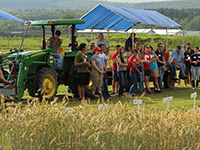Introduction | Participate | Understand | Monitor | Adapt | Mitigate | Activities | Case Studies | Links | Downloadable PDF
Learn how to adapt a garden to changing climate conditions:
Start by introducing youth to concepts such as the difference between native and non-native species. Discuss these differences in the context of what thrives well in a given climate and why? Why is the threat of invasive species greater as global warming increases?
Another important concept to consider is plant adaptation – how does a plant respond to a changing environment and climate? What mechanisms do certain plants have in place to deal more readily with environmental stress, such as drought or changing temperatures?
Plants that are considered to be more adaptable to a change in climate:
- Perennials from Mediterranean climates, which thrive without summer rain (i.e. lavender, rosemary, sage, catmint, oregano, and thyme).
- Local native plants are particularly good for sustaining wildlife, but be sure to ask for ones that will survive the new climatic conditions.
- Choose trees and shrubs that do well across many temperature zones. For example, oak leaf hydrangea, serviceberries, deciduous magnolias and many pines are especially adaptable to a range of conditions.
Factors to consider about plant adaptation to global warming:
- Shifting crops and varieties (and an expansion of agriculture in the Northeast as other regions become less suitable…
- Earlier planting dates (at what risk?)
- Delayed pruning, or less severe pruning?
- Increased need for weed and pest control (increased chemical loads?)
There are many things to consider and gardeners are in a good position to experiment with different strategies of adaptation, without risk of a major economic loss. This activity, Superhero Plants (pdf), helps children think about what attributes a plant has that help it be more or less adaptable to certain climate conditions.









